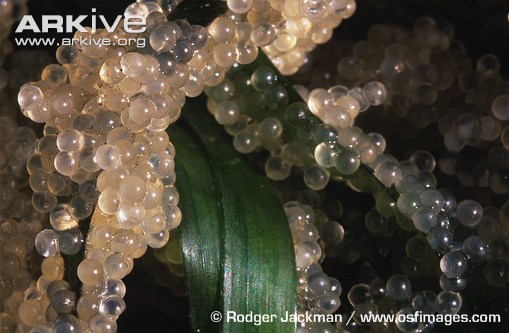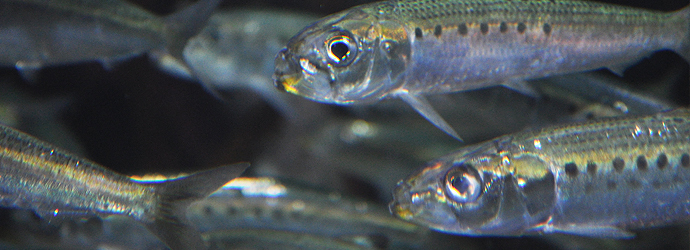Reproduction
Clupea pallasii migrate to inshore to lay their
eggs. They begin to lay their eggs when they are
 between four to
nine years old. Females can lay up to 130,00 eggs in their
lifetime. The number of eggs laid per spawning can range from a
few to twenty or more layers. Most spawning grounds are located in bays, estuaries,
inlets, and some coastlines. These locations are chosen because
they are semi protected. They try to lay their eggs in areas of
high zooplankton concentration, so that when the larvae hatch
they are able to eat. They also try and lay them in areas of low
predation. The reasoning for both of these is that Clupea
pallasii are not born with high visual acuity, therefore
laying them in these specific spots increases their chances of
survival. They often lay their eggs on eelgrass, kelp, or even
some solid substrates like piers and docks.
between four to
nine years old. Females can lay up to 130,00 eggs in their
lifetime. The number of eggs laid per spawning can range from a
few to twenty or more layers. Most spawning grounds are located in bays, estuaries,
inlets, and some coastlines. These locations are chosen because
they are semi protected. They try to lay their eggs in areas of
high zooplankton concentration, so that when the larvae hatch
they are able to eat. They also try and lay them in areas of low
predation. The reasoning for both of these is that Clupea
pallasii are not born with high visual acuity, therefore
laying them in these specific spots increases their chances of
survival. They often lay their eggs on eelgrass, kelp, or even
some solid substrates like piers and docks.
 Once the eggs are laid they take eleven to forty days to
hatch. The time it takes for them to grow, develop, and hatch
depends on the temperature of the spawning ground. Spawning can
occur anywhere from October in some places to August of the next
year in other places. This is suggested to be because of the
zooplankton productivity, which varies from location to location. It
is also common to see the same groups of Pacific herring return to
the same spawning grounds as they did the previous year.
Once the eggs are laid they take eleven to forty days to
hatch. The time it takes for them to grow, develop, and hatch
depends on the temperature of the spawning ground. Spawning can
occur anywhere from October in some places to August of the next
year in other places. This is suggested to be because of the
zooplankton productivity, which varies from location to location. It
is also common to see the same groups of Pacific herring return to
the same spawning grounds as they did the previous year.
Metamorphosis occurs 2-3 months after the larvae have hatched. This is just the stage where the fish undergoes many dramatic physical changes. At this point they range in size from 10-150 millimeters. They are not considered mature until they are two to five years of age. At that point they range from 10-30 centimeters in length. They can travel in schools inshore and off shore to feed and live, and of course return to spawn when the time is right.
Watch this video to see the Pacific herring laying their eggs.
